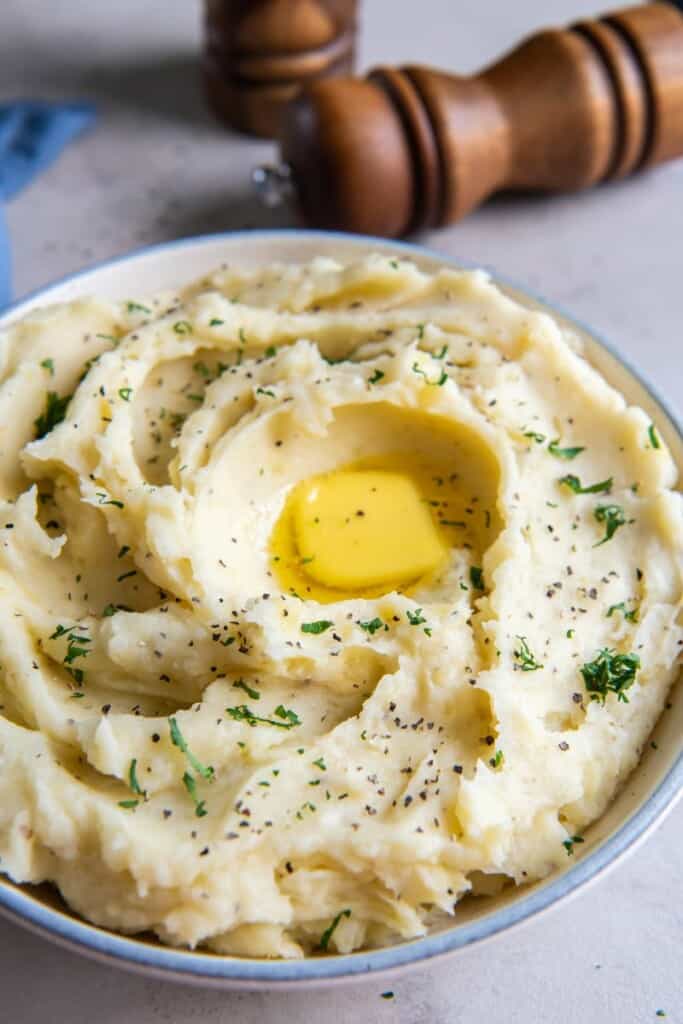I love making mashed potatoes without milk for some easy comfort food. My recipe always turns out creamy, fluffy, and incredibly satisfying for a classic side that adds warmth and flavor to any meal!
This post may contain affiliate links. If you click on a link and make a purchase, I may receive a small commission at no extra cost to you. For more information, please read my disclaimer.
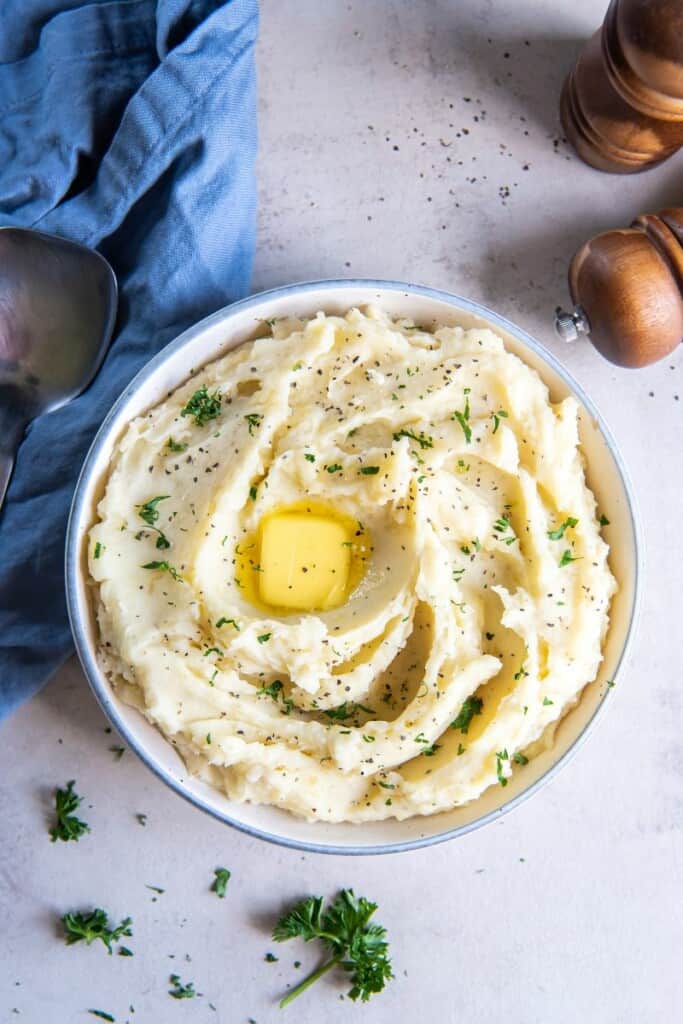
My Easy Homemade Mashed Potatoes Recipe
I love a good mashed potatoes recipe, but I will never forget the one night I had all my potatoes peeled and boiling when I went to grab the milk from the fridge. Turns out while they were boiling, my daughter Leah helped herself to the last of the milk in our house. So, I learned how to make mashed potatoes without milk – and honestly, they were delicious!
The extra butter brought all the fluffiness and creaminess the potatoes needed, and using some of the leftover potato water brought back some extra flavor to the potatoes.
I’ve kept my recipe in my back pocket for when I need to make a dairy-free mashed potato recipe or when we’re just running low on milk, and my family has loved it.
I turn to this recipe even when I have milk in the fridge, and I love switching it up by adding some cream cheese and sour cream. Both are fantastic additions, by the way.
My husband Ben goes back for seconds constantly when I make them, and I’ve even heard him give an audible “yummmm,” while stuffing his face with them.
And, if you love a good potato recipe, try my recipes for sweet potato casserole, twice baked potatoes, 4 ingredient potato soup, air fryer smashed potatoes, and twice baked mashed potatoes.
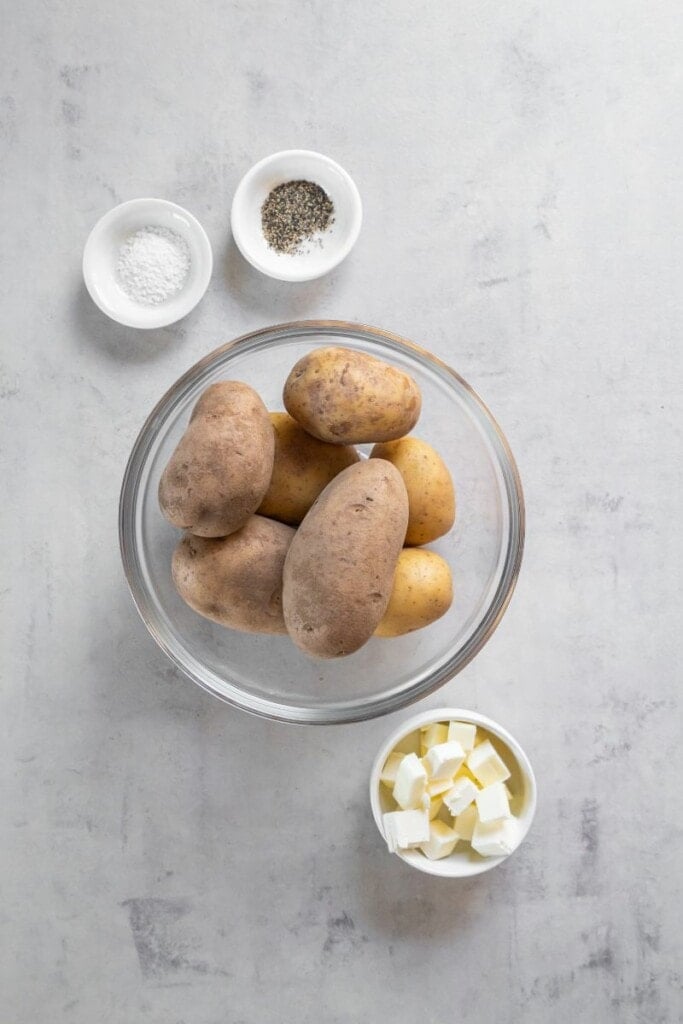
Mashed Potatoes Without Milk ingredients
- Potatoes — I use russet or yukon gold potatoes because of their starch content to get the dish extra fluffy
- Potato water — this adds some flavor back into the potatoes. I’ve used veggie and chicken broth with success too
- Butter — this adds the creaminess to homemade mashed potatoes
- Salt and pepper — these always brighten the flavors inside the potatoes
How to Make Mashed Potatoes Without Milk
A full printable version of this recipe with ingredient measurements is available at the bottom of this post.
STEP ONE: Place the cubed potatoes into a large pot, then add cold water until they are covered by about an inch. Add salt to the water and bring it to a boil, allowing the potatoes to cook until they become fork tender — around 15-20 minutes.
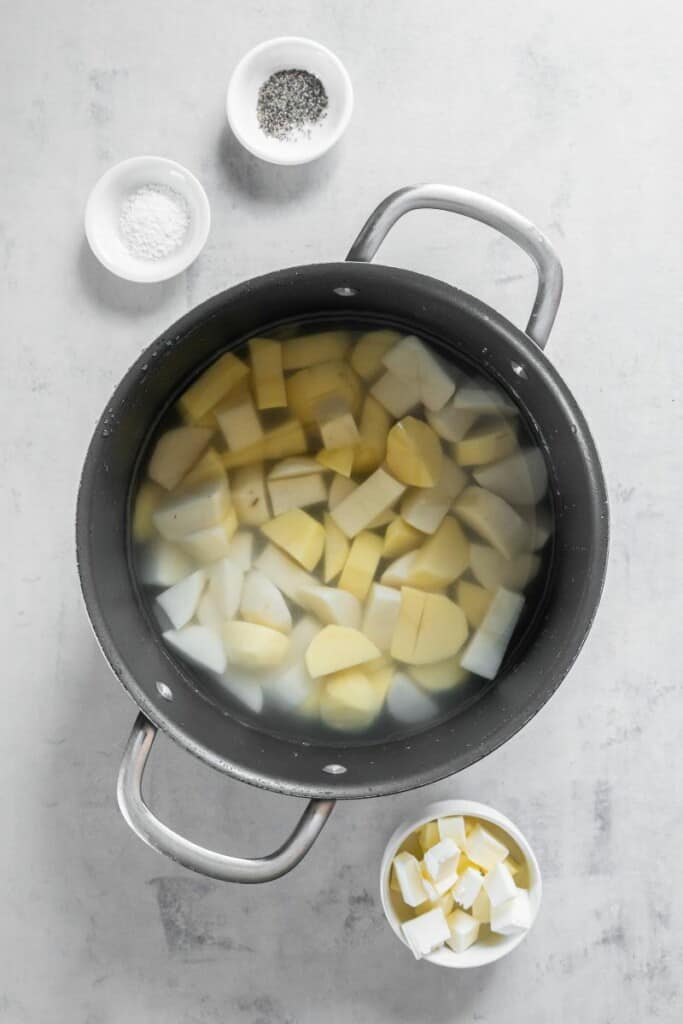
STEP TWO: Once the potatoes are cooked, reserve 1 cup of the starchy water and drain the rest. Return potatoes to the pot and add the butter.
STEP THREE: Gently mash the butter into the potatoes until it’s completely melted and well combined.
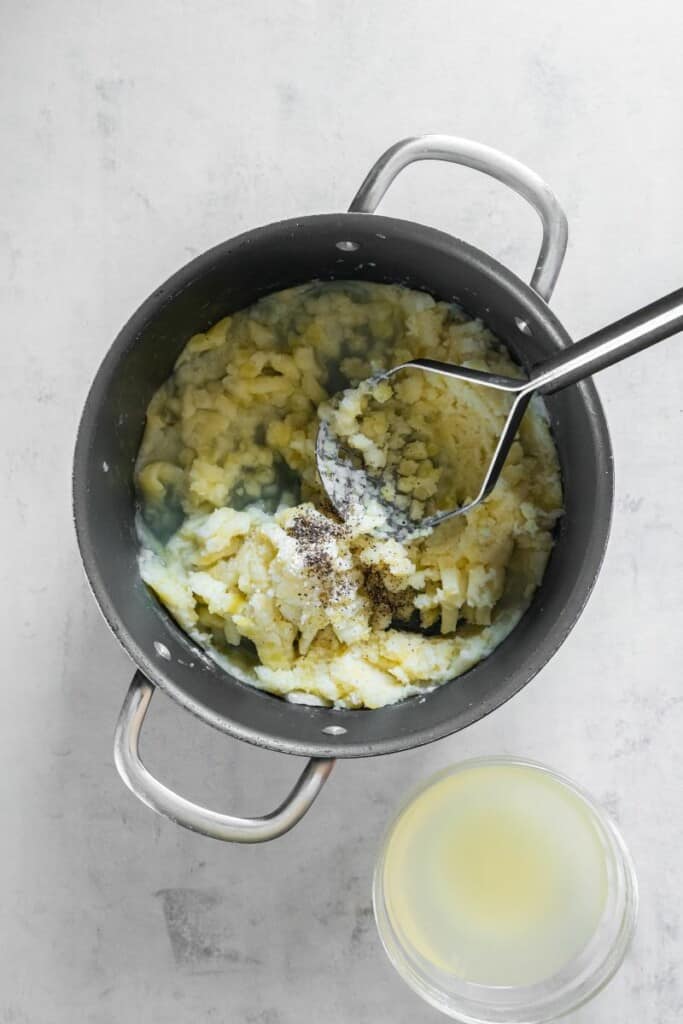
STEP FOUR: Gradually introduce the cream cheese or sour cream, if using, along with the potato water back into the mixture with a potato masher until it is creamy. Season to taste and serve while hot.
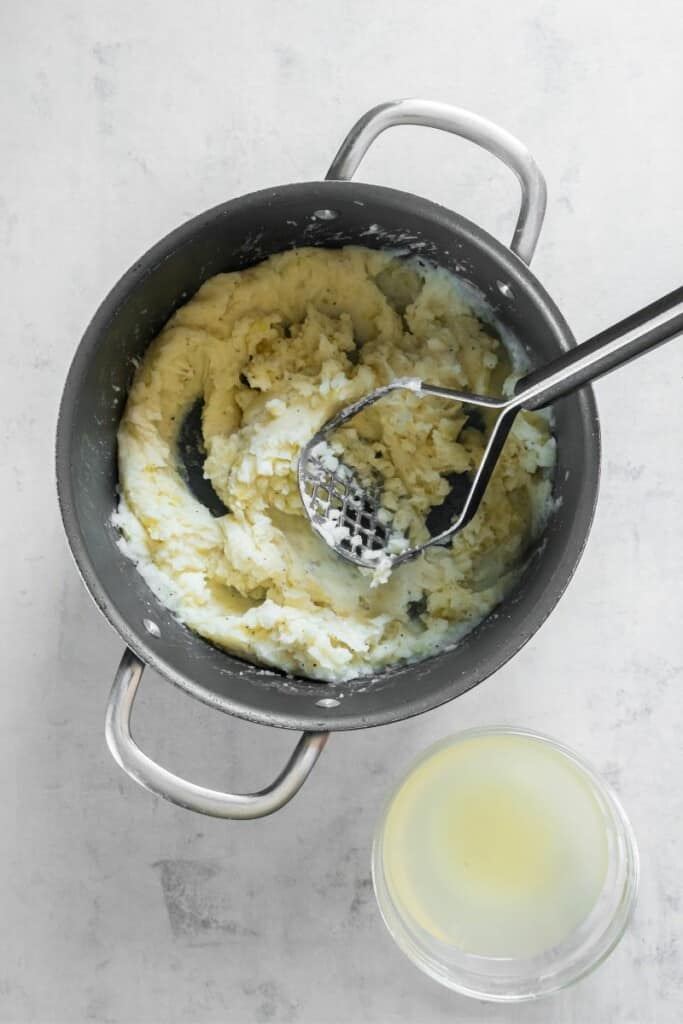
Tips for the Best Mashed Potatoes with No Milk
- I always use Yukon gold or russet potatoes for their higher starch content. I’ve noticed they break down much easier so I get a super creamy texture.
- Cube the potatoes evenly so all the pieces are roughly the same size. I get much more consistent results this way compared to uneven pieces that don’t cook at the same rate.
- Cook the potatoes until the flesh pierces easily with a fork. In my experience, there’s nothing worse than trying to mash under cooked potatoes!
- Use a potato masher rather than a hand mixer that can release too much starch. This is my secret to getting the best, fluffiest texture. I’ve also used a potato ricer.
- Test the flavor and adjust salt and black pepper as necessary. Potatoes absorb a lot of salt, so I always test to see if I need to add more to really bring out the flavors.
Homemade Mashed Potatoes Variations and substitutions
- Swap out the butter for olive oil or dairy-free butter for dairy-free mashed potatoes. I always use quality olive oil for this variation for the best flavor!
- Mix in fresh herbs like rosemary or thyme for a lovely aromatic touch. Around the holidays, I really like to use herbs in my mashed potatoes.
- Add roasted garlic cloves and chives for a huge boost of flavor. Garlic mashed potatoes are my husband’s favorite version!
- For a spicy twist, add some cayenne pepper. I just love the warmth this adds to mashed potatoes.
- If no one is sensitive to dairy, mix in 4 oz. of cream cheese or ½ cup of sour cream for extra creamy mashed potatoes. This really dials up the richness!
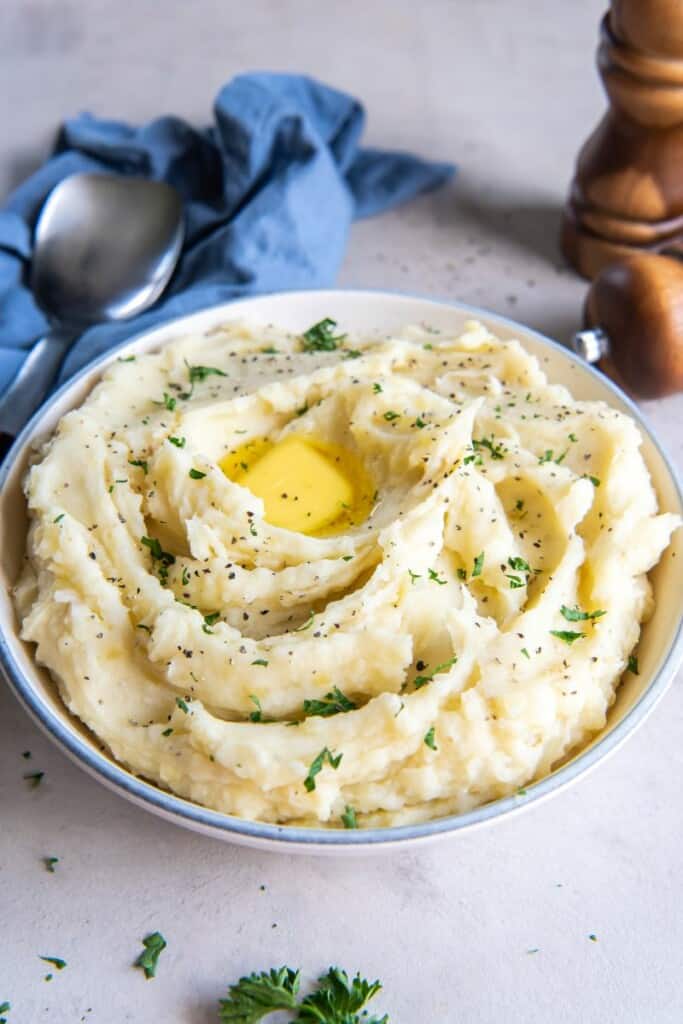
What to Serve With Mashed Potatoes Without Milk
Mashed potatoes are a classic to serve with a Thanksgiving turkey, but I love making them for all kinds of occasions! I roast whole chicken in the oven, make baked chicken tenders, or cook pork tenderloin in the oven to go with this delicious side.
For holiday occasions like Christmas, I find these mashed potatoes pair well with a spiral ham and a little mushroom gravy or ham gravy on top!
More Ideas for a Substitute for Milk in Mashed Potatoes
- Add cream cheese or sour cream in place of milk in your favorite recipe. I love how this keeps the mashed potatoes extra creamy and full of flavor!
- My go-to trick is to use the boiled water from the pot as a substitute for milk in mashed potatoes! Reserve a full cup, but mix it in a few splashes at a time so the mashed potatoes don’t become too dense.
- Chicken or vegetable broth is an easy substitute, and I like how they add an extra layer of flavor.
- I sometimes use mayonnaise as a substitute for milk for super rich mashed potatoes. I add the mayo in small amounts and blend until I achieve my desired consistency.
- Non-dairy milk alternatives like almond milk or rice milk keep things creamy without altering the flavor too much. I’ve also used oat milk, which is thicker and creamier. I just make sure to use unsweetened and unflavored!
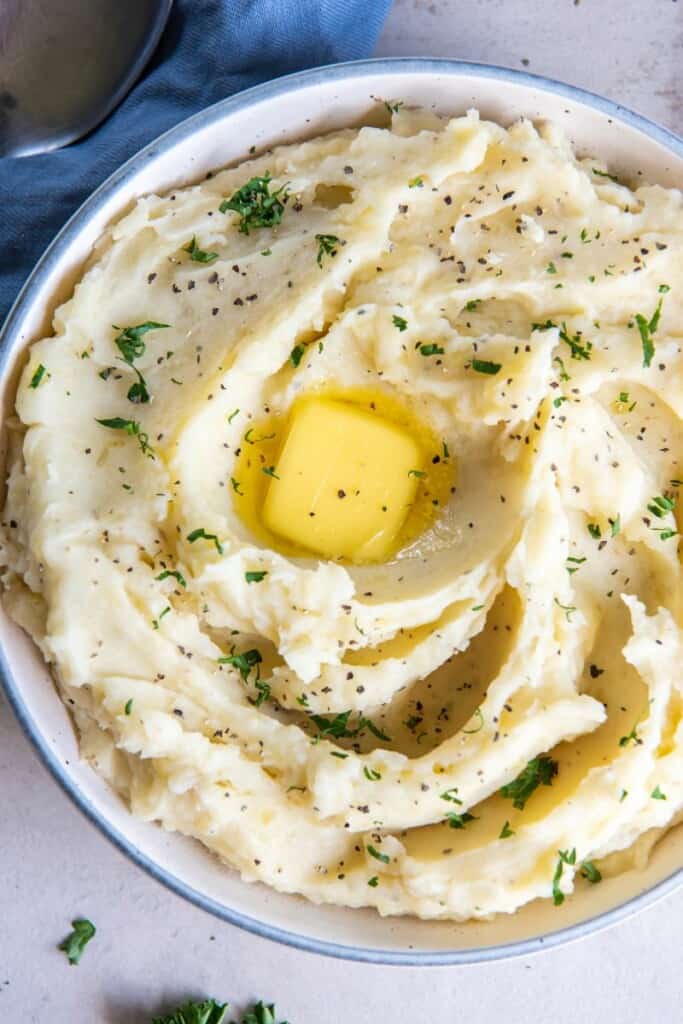
How to Make Mashed Potatoes Without Milk FAQs
How do I reheat Homemade mashed potatoes?
If I want to reheat a large quantity of mashed potatoes, I’ll preheat the oven to 350 degrees F and then warm the dish for 15-20 minutes, covered. I’ve also tried reheating on the stove, but the trick is not to stir too much and to add splashes of broth as needed.
If I’m reheating an individual serving, I think the easiest option is the microwave. I heat for 1 minute on half power, add a splash of broth, then repeat until the mashed potatoes are heated all the way through.
How do I fix mashed potatoes that are gummy and dense?
Too much starch can give mashed potatoes a glue-like consistency, so I start by rinsing the chopped potatoes to remove some of the starch. Mixing and mashing will also release extra starch, so instead of a hand mixer, I prefer to use a hand masher and go slowly.
If I do accidentally over mix my mashed potatoes, folding in a drizzle of melted butter can help recover some of that fluffy texture.
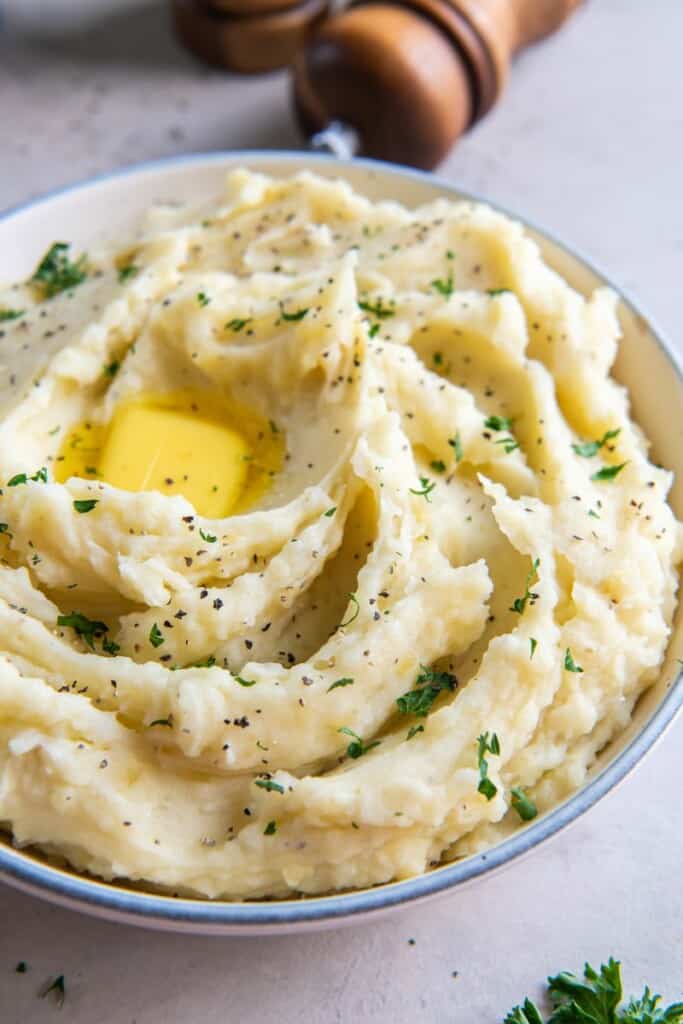
Why aren’t my mashed potatoes fluffy?
If the potatoes release too much starch, it can make the mashed potatoes dense. The trick is to avoid over-mixing or over-mashing and to go slowly.
What is the best kind of potatoes to use for mashed potatoes without milk?
Russet potatoes are my favorite for making mashed potatoes without milk! They break down the easiest, so I don’t have to worry about mixing or mashing them too much. These are my go-to for the fluffiest mashed potatoes!
Yukon gold potatoes are a good alternative. They have less starch, so I reach for Yukons when I want a balance of fluffy and creamy textures.
Do I need to peel potatoes for this mashed potato recipe?
I always peel my potatoes before cubing and boiling them. Peeling them gives me the smoothest mashed potatoes possible and makes mashing them much easier.
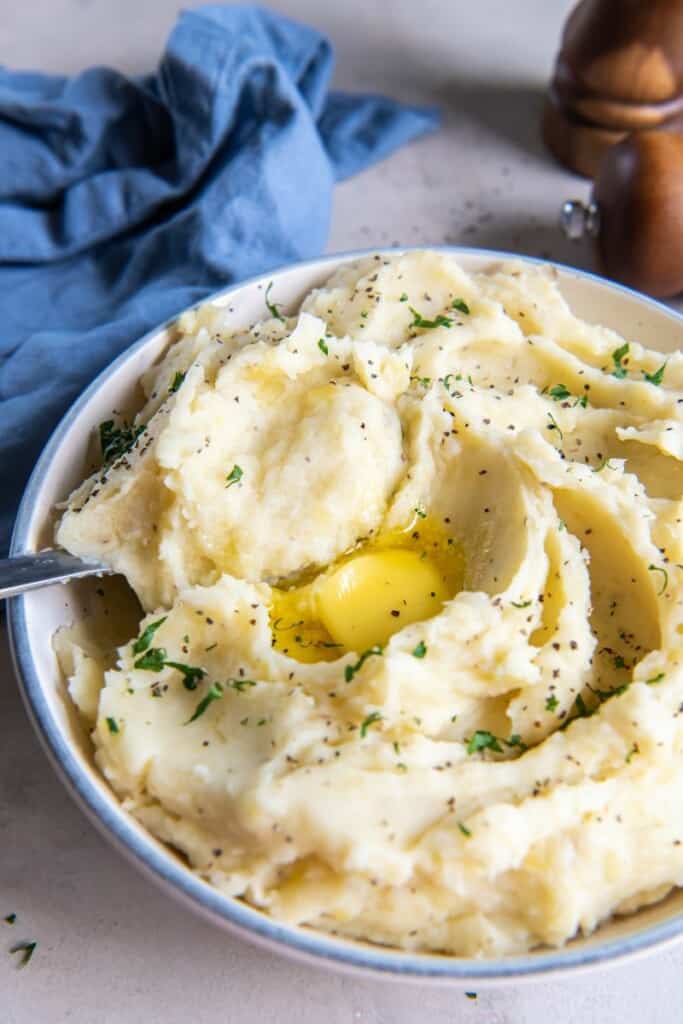
How should I store leftover mashed potatoes?
I let my leftover mashed potatoes cool completely, then store them covered in an airtight container or the refrigerator for up to 3 days.
More Easy Side Dish Recipes
- Grape salad recipe
- Velveeta mac and cheese
- Acorn squash recipe
- Fruit salad with cool whip
- Green bean casserole with cream cheese
- 5 ingredient squash casserole
- Cornbread stuffing
- Jello salad
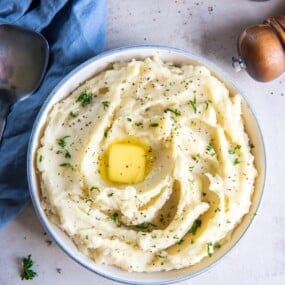
Creamy Mashed Potatoes Without Milk
Ingredients
- 2 pounds russet or yukon gold potatoes peeled and cubed
- 1 cup reserved potato water or broth
- ¼ cup unsalted butter softened
- Salt and pepper to taste
Optional (for an extra creamy mashed potato recipe)
- 4 oz. cream cheese or 1/2 cup sour cream
Instructions
- Place the cubed potatoes in a large pot and add enough water to come up over them by about 1 inch.
- Add salt and bring the water to a boil, cooking until potatoes are tender, 15-20 minutes.
- Drain potatoes through a fine-mesh colander, reserving 1 cup of the potato water, then return the potatoes to the pot.
- Add the butter and mash it into the potatoes until it’s melted.
- Slowly add the reserved potato water and cream cheese or sour cream, if using, blending it in with a potato masher until the potatoes are smooth and creamy.
- Season with salt and pepper to taste.
Notes
- Yukon gold and russet potatoes work best because of their higher starch content.
- Cube the potatoes evenly so all the pieces are roughly the same size.
- Cook the potatoes until the flesh pierces easily with a fork.
- Use a potato masher rather than a hand mixer that can release too much starch.
- Test the flavor and adjust salt and black pepper as necessary. The potatoes absorb a lot of salt, so always test to see if more is needed.
- Store leftovers covered in an airtight container or the refrigerator for up to 3 days.
- Reheat leftovers in the oven at 350 degrees F for 15-20 minutes when reheating in bulk, or in the microwave at half power for about 1 minute for an individual serving.
Nutrition
This nutrition information is based on the exact products I used in this recipe. Brands and sizes of products could alter exact nutrition and should always be calculated independently.
